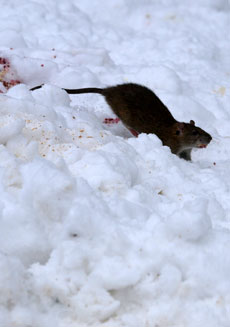Did a harsh winter help by killing off rats?
![]()
The bitter cold of Wednesday is expected to be a memory by this morning, with temperatures forecast to rise to the 60s through the weekend. That could mean a return of the rats that were disturbing the city as recently as October – just before the Polar Vortex hit and gave Cambridge and the country the coldest winter since 2009-10, the 34th coldest winter on record.
There was one way the cold was supposed to be a good thing.
As Public Works officials told the East Cambridge Planning Team at an October 2012 meeting, when team president Barbara Broussard talked of how “we’ve never seen rats like this in 15 years … when we see rats crossing the street that are bigger than my dog, we have a problem,” it wasn’t just massive amounts of construction causing the infestation, but abnormally warm winters. Cold winters kill rats, and the winters of 2010-12 didn’t.
Did the Polar Vortex that swept through three times this winter mean fewer rats for Cambridge? Public Works officials weren’t sure, giving this response through Lee Gianetti, the city’s director of communications and community relations:
During winters with harsher temperatures or significant snowfall, rats will hunker down longer than they normally would. Whether or not these conditions would lead to significant impacts on the rat population is not something the city is qualified to speculate on; however, staff will continue efforts around prevention and response to rodent problems.
The answer is a little uncertain even from an expert such as Stephen M. Vantassel, a wildlife control consultant from the School of Natural Resources at the University of Nebraska at Lincoln.
“Harsh winters can increase animal mortality, but I doubt the public will see any difference with rats,” Vantassel said when asked about Cambridge’s chances. “Rats have excellent reproductive capability, and people have low tolerance – so one rat will appear like lots.”
There was one definite answer, though, and the answer is no, the colder winter that just ended doesn’t mean fewer rats in the coming months.
Sorry, no
Although she described it as an “educated guess,” Judy Chupasko, of the Mammalogy Department at Harvard’s Museum of Comparative Zoology, said there are too many places for rats in a city to burrow in and wait out extreme cold for this winter to have caused a die-off.
“If you were talking about bear mice in a forested area, they would be more affected by a harsh winter,” Chupasko said.
One clue is that the winter didn’t affect ticks, either. The horse Chupasko keeps at her Haverhill home has already been afflicted with so many ticks it “shocked” her – and they’ve been latching on even before the horse has had its first trip on a trail this year.
“I would suspect there should be less, because it was really brutal, right? Just from common sense you probably would see a drop if you had a harsh winter. But it probably depends on a lot of other factors,” Chupasko said of the three species of rats most common to cities. “Are there sites where they can stay where it’s out of the weather, like underground areas like the subway? Are there nooks and crannies or basements of buildings? It’s kind of different when you’re in a human populated area – the animals can kind of get around natural forces like weather because there’s a lot of places to hide and stay warm.”
“Like humans, we weren’t meant to be in really cold areas, but we’ve been able to inhabit almost to the North Pole because we modify our environment. We build buildings and we heat them,” she said. “I would suspect any pest animals that are associated with humans and cities and big apartment buildings would benefit from us surviving through a winter and ride on our coattails. They’re in a manmade shelter.”



